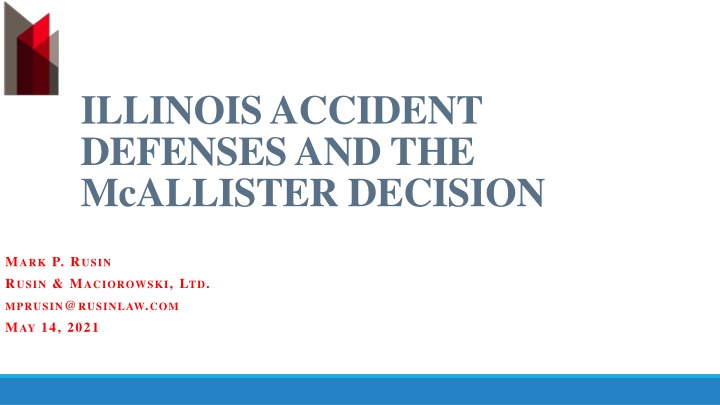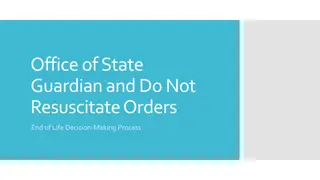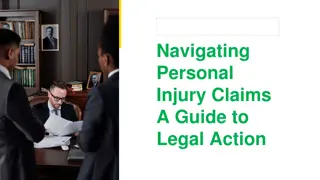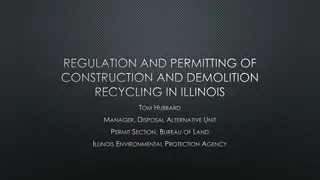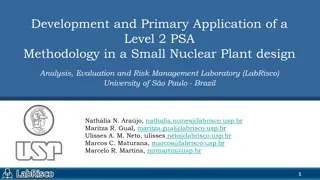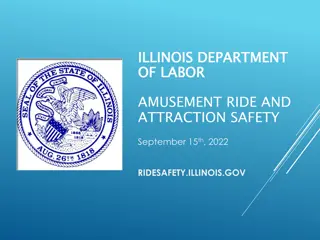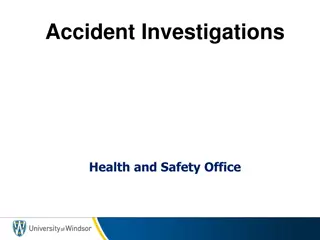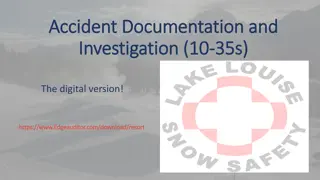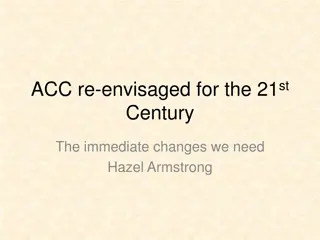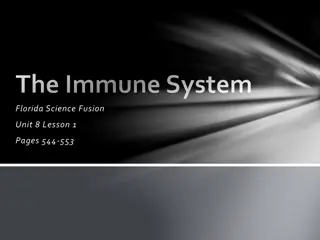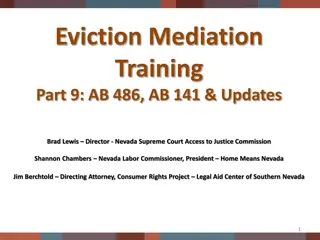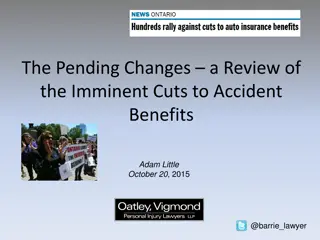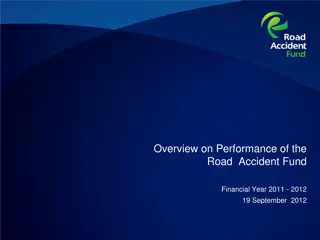Illinois Accident Defenses and McAllister Decision Overview
Illinois accident defenses encompass fraud, occurring in the course of employment, and arising out of employment. Fraudulent claims often exhibit signs like delayed reporting and inconsistencies. Claims must be examined for their alignment with the context of employment. Illinois law requires a demonstration that injury risks are work-related for compensation. The three categories of risk include employment-related, personal, and neutral risks. A case example illustrates a scenario where a mechanic's actions led to an injury in a factory setting.
Download Presentation

Please find below an Image/Link to download the presentation.
The content on the website is provided AS IS for your information and personal use only. It may not be sold, licensed, or shared on other websites without obtaining consent from the author.If you encounter any issues during the download, it is possible that the publisher has removed the file from their server.
You are allowed to download the files provided on this website for personal or commercial use, subject to the condition that they are used lawfully. All files are the property of their respective owners.
The content on the website is provided AS IS for your information and personal use only. It may not be sold, licensed, or shared on other websites without obtaining consent from the author.
E N D
Presentation Transcript
ILLINOIS ACCIDENT DEFENSES AND THE McALLISTER DECISION MARK P. RUSIN RUSIN & MACIOROWSKI, LTD. MPRUSIN@RUSINLAW.COM MAY 14, 2021
ACCIDENT DEFENSES FALL INTO THREE GENERAL CATEGORIES Fraud Accident Must Occur in the Course of Employment Accident Must Arise out of Employment
FRAUD = FABRICATED ACCIDENT CLAIM Top Signs an Accident Claim is Fabricated Late/delayed accident reporting Inconsistent accident reporting Alleged accident occurred shortly before layoff, expected termination, strike, project completion, etc. Alleged accident occurs shortly after reprimand, discipline or termination Unwitnessed Significant history of prior claims, settlements, accidents, injuries, pre- existing conditions, etc. History of criminal activity related to dishonesty
IN THE COURSE OF EMPLOYMENT References Time Place -Activity Question: Is the claimant where he/she is supposed to be, doing what he/she is supposed to be doing, at the time he/she is supposed to be doing it? Examples 1. Going to and from work 2. Deviations from employment
ARISING OUT OF EMPLOYMENT Illinois does not follow the positional risk doctrine. The mere fact that claimant was present at his/her place of employment will not itself suffice to establish that the injury arose out of employment. Rather, a claimant must demonstrate that the risk of the injury sustained is peculiar to one s employment, or that it is increased as a consequence of work. See Brady v. L. Ruffolo Sons Constr. Co. (Supreme Court of Illinois, May 20, 1991). Thus, we must identify, evaluate and develop evidence related to risks causing injuries to determine if a reasonable arising out of defense exists!
THE THREE CATEGORIES OF RISK Employment Related Risks always compensable Personal Risks not compensable Neutral Risks may be compensable but only when exposure to a common risk to a greater degree than the general public
CASE EXAMPLE #1 FACTS: Claimant is a mechanic for a factory that produces glass bottles. On his own, claimant removed metal scrap from the company garbage bin. He operated a band saw (in violation of safety rules) without putting the saw guard down in order to cut and remove an ornament from the metal scrap. The employer did not request or anticipate this action. Claimant testified he believed the metal ornament would be useful in another area of the factory. While operating the band saw, he lacerated a finger. 1. How would you characterize the risk that caused the injury? 2. Is this compensable?
STOUT V. GERRESHEIMER 08 WC 31469 The Illinois Workers Compensation Commission found credible claimant s testimony that he was cutting the metal ornament to use in another area of the plant for the benefit of his employer. Thus, benefits are award for injuries resulting from an employment related risk.
CASE EXAMPLE #2 FACTS: Claimant utilized an industrial oven to heat a frozen pie to eat. The employer was unaware of the conduct. The employer did not acquiesce in the conduct. Claimant was injured while heating the pie. 1. How would you characterize the risk that caused the injury? 2. Is this compensable?
SEGLER V. INDUSTRIAL COMMISSION 81 ILL.2d 125 A voluntary personal risk caused this injury. engaged in an unreasonable and unnecessary risk which was inherently dangerous. Claimant Thus, benefits were denied for injuries resulting from this personal risk undertaken by claimant.
CASE EXAMPLE #3 FACTS: Decedent was employed to perform maintenance work on the grounds of a condominium complex. Decedent was shot and killed while allegedly performing maintenance activities on the complex grounds. No evidence was presented to establish the motive or reason for the shooting. No evidence was presented regarding the incidence of crime in the area. 1. How would you characterize the risk that caused this fatality? 2. Is this compensable?
MORADEL V. WHISPERING WINDS CONDO ASSOCIATION 12 WC 19102, IWCC REVIEW DECISION The fatality was the result of a random act of violence which is neutral risk. No credible evidence was presented that decedent s employment placed him at an increased risk of violence than is faced by the general public. Thus, the claim for compensation is denied on the basis the accident did not arise out of employment.
CASE EXAMPLE #4 FACTS: Claimant is employed as a packer. He left the company building was walking to his car parked in the employee parking lot. He was walking down a sidewalk with a curb running along its edge. Claimant walked along the sidewalk for about 30 feet and then stepped off the curb onto the blacktop driveway. There was a slight cement slope. As claimant stepped off the curb, his right foot landed half on the cement incline and half on the blacktop driveway and he twisted his ankle. The driveway was on the company premises. There were no holes, rocks or obstructions on the pavement. 1. How would you characterize the risk that caused the injury? 2. Is this compensable?
CATERPILLAR TRACTOR V. IL IND. COMM. ILLINOIS SUPREME COURT, JUNE 19, 1989 Walking and traversing curbs is a common activity. It is not a risk distinctive to the employment of claimant. No evidence was presented that the curb was defective, hazardous or unusual. Claimant was exposed to a neutral risk in walking and traversing curbs. Claimant was no more likely to twist his ankle than he would have been had he been engaged in any other business. Thus, the accident did not arise out of employment and the claim for compensation denied.
IMPORTANT TAKEAWAY FROM CATERPILLAR The Court does not find the activity of walking and traversing a non-defective curb distinctive or incidental to the employment. Same applies to stairs. Common every day risks. The Court identifies three scenarios for activities to be considered employment related risks, thereby arising out of employment. They are acts which: Employee was instructed to perform by the employer; Employee has a common law or statutory duty to perform; Employee might reasonably be expected to perform incident to his assigned duties.
POST CATERPILLAR 1989 We interpreted any common activities or maneuvers of daily living to involve neutral or personal risks We required evidence of increased risk associated with the activity to establish compensability. McAllister scrutinizes and modifies this concept.
McALLISTER V. IWCC/NORTH POND LLINOIS SUPREME COURT, SEPT. 24, 2020 FACTS: Kevin McAllister is a sous chef for North Pond Restaurant. On the accident date, he was searching for a pan of misplaced carrots. He went into a walk-in cooler to locate the carrots and while kneeling on both knees, he checked the top, middle and bottom shelves. He did not find the carrots. He had nothing in his hands. As he attempted to stand from a kneeling position, his right knee popped and locked up. He had a prior knee injury and had undergone surgery on the right knee one year earlier. He suffered a re-tear of the medial meniscus and had surgery. 1. How would you characterize the risk that caused the injury? 2. Is this compensable?
McALLISTER COURT RULING Claimant is a chef responsible for arranging the walk-in cooler. He had a duty to find misplaced carrots kept in the walk-in cooler. reasonable to expect claimant to look for the carrots. The claimant s knee injury arose out of employment because at the time he injured his knee searching for misplaced carrots, he was at work performing an act his employer might reasonably expect him to perform. The knee injury was caused by kneeling and standing while searching for carrots. It was Thus, the injury is the result of an employment related risk and arose out of employment.
HANG ON! WHAT ARE THEY DOING? HOW DO THEY ARRIVE AT THIS CONCLUSION? 1. Didn t McAllister have a pre-existing condition and sustain injury due to a common maneuver? 2. Isn t this a the result of a personal or neutral risk? 3. How is this supposed to work?
ANALYSIS FROM THE McALLISTER DECISION The Court explains and redefines the arising out of concept particularly for injuries resulting from common maneuvers. The Court focuses first on whether a causal connection exists between claimant s injuries and an employment related risk. The Court recognizes common bodily movements or routine everyday activities causing injury may arise out of employment when they occur due to a risk distinctly associated with employment. A risk is distinctly associated with a claimant s employment (employment related risk) in the following 3 scenarios: 1. Employee engages in acts he or she was instructed to perform by the employer; 2. Employee engages in acts he or she had a common law or statutory duty to perform; 3. Employee engages in acts he or she might reasonably be expected to perform incident to his or her assigned duties.
ANALYSIS FROM THE McALLISTER DECISION CONTINUED If it is established that the risk of injury falls within one of the three categories of employment related acts, then it is established the injury arose out of employment. Further analysis of the risk and whether it qualitatively or quantitatively exposed claimant to a greater risk than he or she would have otherwise been exposed is not required. If the risk of injury does not fall within one of the three categories of employment related acts, then a neutral risk analysis should be applied. In this scenario, claimant must provide additional evidence establishing either qualitatively or quantitatively that he or she was exposed to a risk of injury to a greater degree than the general public. Brady v. Ruffolo Court Decision finding we are not a positional risk state is not overturned. Caterpillar Court Decision denying compensation for injuries caused by a common maneuver (stepping up a curb) is not overturned.
ANALYSIS FROM MCALLISTER CONTINUED Common maneuvers and movements are no longer classified as neutral risks if related to an act distinctly associated with one s employment. To support a liability defense on the basis the accident did not arise out of employment when common maneuvers result in injuries, you must: Establish the common maneuver is unrelated to acts distinctly associated with a claimant's employment and classify them as neutral risk; Develop and present evidence that the claimant was not exposed to an increased risk of injury in performing the maneuver because of the employment. (Either qualitatively or quantitatively).
CONCLUSIONS Injuries resulting from personal risks are not compensable. Therefore, if possible, create arguments that the condition is the result of a personal risk of claimant. In these scenarios, attempt to develop evidence of pre-existing conditions as the cause of the condition or that the condition was of spontaneous onset (unrelated to any incident or activity). If it is apparent the condition is related to a common maneuver, your goal is to create evidence that the activity at is not distinctly related to a claimant s employment duties. General activities of daily living are not distinctly associated with employment. (i.e. walking, standing, stepping up and down curbs or steps) We know the activity claimant engaged in (stepping down a curb) in Caterpillar was not distinctly related to the employment. Use this as a guide and in support of your position, if possible. Investigation and development of evidence of a claimant s job duties is crucial. conjunction the activity at issue. Analyze those duties in Additionally, investigation and development of evidence to refute the claim that employment increased the risk of injury is essential.
STRATEGIES Develop evidence to establish the injury is the result of a voluntary personal risk. How: 1. Create detailed job descriptions. a. Specify essential job duties. b. Specify materials and machinery involved. c. Specify weights. d. Specify frequency. e. Specify time duration of tasks. 2. Review, update and revise company policies and safety rules, if necessary. 3. Modify accident reports to include a section analyzing activity/risk. a. Document whether activity is distinctly associated with claimant s job duties. b. Document whether activity is associated with an activity of daily living. c. Document whether activity is associated with voluntary personal hazardous action. i.e. horseplay, safety rule violation, intentional hazardous act.
STRATEGIES CONTINUED Develop evidence to establish the injury is the result of a preexisting condition/ personal medical condition. How: 1. Investigate claimant s medical history. a. Obtain all related medical. b. Identify primary care provider and obtain records. c. Identify group insurer and obtain records. d. Obtain medical canvas. e. Investigate prior claims history. f. Interview management and coworker regarding prior complaints and conditions.
MARK P. RUSIN RUSIN & MACIOROWSKI, LTD. MPRUSIN@RUSINLAW.COM MAY 14, 2021
